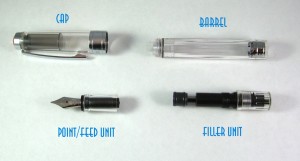How Do Fountain Pens Work
Considered the king of all writing instruments, this pen has a complex design and structure.
Fountain pens work, in general, by transporting ink from a sealed container (usually a cartridge) through a hole, into a finned feed and down to the tip of the nib.As the nib comes into contact with a surface, such as a sheet of paper, the ink is drawn out of the nib through capillary action, causing more ink to be drawn through the feed from the sealed container.
 Importantly, as the containers sealed, a vacuum is created within as the ink is removed and this – in partnership with the ink’s surface tension as well as its molecular attraction to the pen’s metal nib – causes it to flow in a controlled and consistent way. It also means the ink ceases to flow when the nib is lifted.
Importantly, as the containers sealed, a vacuum is created within as the ink is removed and this – in partnership with the ink’s surface tension as well as its molecular attraction to the pen’s metal nib – causes it to flow in a controlled and consistent way. It also means the ink ceases to flow when the nib is lifted.
Fountain pen teardown
Nib – The point of contact for the pen, the nib narrowly distributes ink onto a writing medium like paper. Nibs are commonly made from gold plate to avoid corrosion.
Cap – A protective cover for the delicate pen nib, the cap is often installed with a clip for easier portability.
Feed – Arguably the most important part of the pen, the feed controls the flow of ink out of the reservoir and distribution to the nib. The feed on a modern pen is commonly made from hard rubber or vulcanite.

Barrel – The casing for the internal components, the barrel tends to be made from plastic or lightweight metals. It is often tapered for ergonomie purposes.
Reservoir – A sealed container, such as a cartridge, that holds the pen’s ink. Ink is drawn from the reservoir into the feed for controlled distribution.
Section – The lynchpin of the pen, the section holds together all of the various parts within the barrel and cap, including the feed, breather tube and nib.
